#birefringence
Text

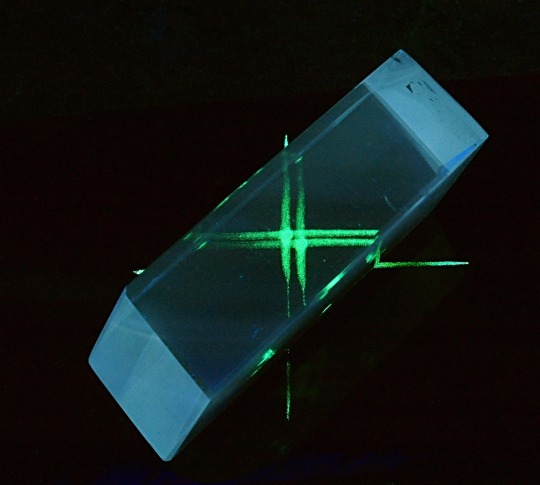
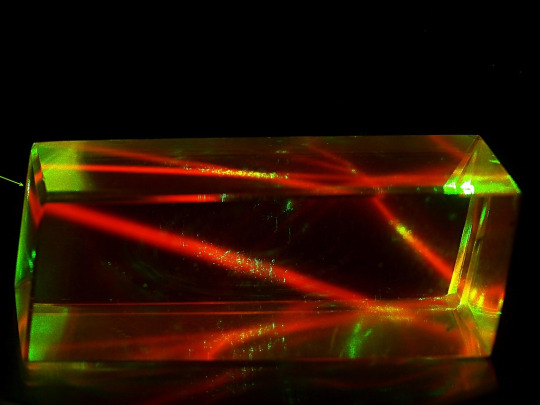

birefringence & fluorescence from lasers through calcite
#one beam enters. two beams leave. said like a wrestling announcer#lasers#calcite#birefringence#fluorescence#geology#gems
212 notes
·
View notes
Text

This demantoid is viewed through a polished window that is roughly parallel to the (110) crystal face. The sample was photographed with cross-polarized lighting and immersed in methylene iodide to high light the anomalous birefringence. The sample measures 8.8 mm across. Photomicrograph by Aaron Palke.
200 notes
·
View notes
Text
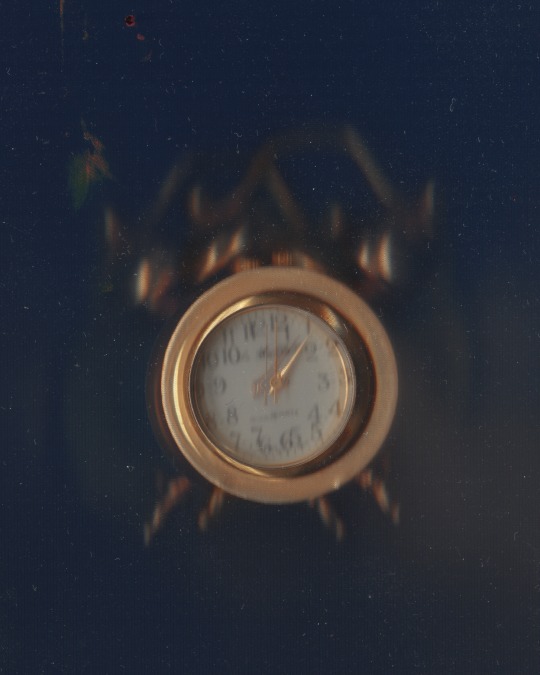
#alternative photography#scanography#original work#trippy#wallpaper#artistic photography#time#clock#birefringence
43 notes
·
View notes
Text
Birefringence Benefits
Shape of the white of the eye (the sclera) – at the back of the eyeball influences vision. Measuring changes in the scleral optical property called birefringence using a new tool called TRIPS-OCT brings promise of predicting short-sightedness and complications
Read the published research paper here
Still from video from work by Xinyu Liu and colleagues
Singapore Eye Research Institute, Singapore National Eye Centre, Singapore, Singapore
Video originally published with a Creative Commons Attribution 4.0 International (CC BY 4.0)
Published in Nature Biomedical Engineering, June 2023
You can also follow BPoD on Instagram, Twitter and Facebook
#science#biomedicine#immunofluorescence#neuroscience#biology#birefringence#sclera#eyeballs#eyesight#myopia#sciart
12 notes
·
View notes
Photo
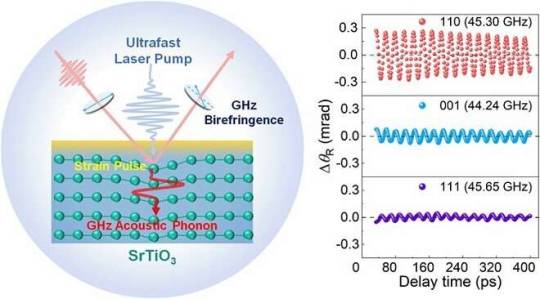
Coherent phonon-induced gigahertz optical birefringence realized in strontium titanate
Using ultrafast time-resolved pump detection technology, researchers led by Prof. Sheng Zhigao from the Hefei Institutes of Physical Science (HFIPS) of the Chinese Academy of Sciences have realized the gigahertz (GHz) frequency birefringence modulation induced by ultrafast coherent phonons in strontium titanate (SrTiO3) crystals.
According to the researchers, the operating frequency was found to be much higher than the cutoff frequency of the commercially available photoelastic modulators.
The study was published in Advanced Science.
A special material with birefringence can shape light. The photoelastic modulator based on birefringence modulation technology is one of the core components of modern optical technology. At present, most photoelastic modulators use the mechanical stress provided by piezoelectric materials to drive photoelastic crystals to achieve birefringence modulation, and their operating frequency is limited by the resonant frequency of photoelastic/piezoelectric crystals, which is generally in the order of kilohertz (kHz). Therefore, there is an urgent need to develop birefringent materials and modulation techniques with GHz operating frequency.
Read more.
13 notes
·
View notes
Audio
"Dissected Grace" by Jute Gyte - From "Birefringence" (2019)
8 notes
·
View notes
Text
7 exams down, 1 to go
#so the electrodynamics section was quite as awful as previous years#however he did include a question at the end about birefringence which isn't something we learnt in this course at all#we learnt about it in Optics which was in the other foundations of physics module#so at least I could write something#but I didn't add a note saying that it wasn't part of the course#I think I've done alright overall#I'm just glad this is over and I never have to do electrodynamics again#the final exam is on monday and is classical mechanics and quantum theory#panda's post
7 notes
·
View notes
Text
Birefringent Crystals
Birefringence is an optical property exhibited by materials whose refractive index varies with the polarization and direction of light propagation. These optically anisotropic crystal materials are said to be birefringent crystals. OST Photonics offers several birefringent crystals such as YVO4 and a-BBO crystals, etc.
What Are the Applications of Birefringent Crystal?
Birefringent crystal is an important photoelectric functional crystal material, which is widely used in the field of optical polarizer, optical modulation and nonlinear optical technology.
FAQS about Birefringent Crystals
What Is Birefringence?
When a beam of light strikes an interface of crystal, it typically generates two refracted beams, which is known as the phenomenon of birefringence.
Which Crystals Have Birefringence?
Calcite(CaCO3), YVO4, Alpha-BBO, Quartz, MgF2 and LiNbO3 crystals exhibit birefringence.

1 note
·
View note
Note
Do you have any neat calcites?
Do I ever!! Here are just a few of my favorites.

Here’s a specimen of huge brown barite crystals on a druzy of yellow calcite, from Elk Creek South Dakota.
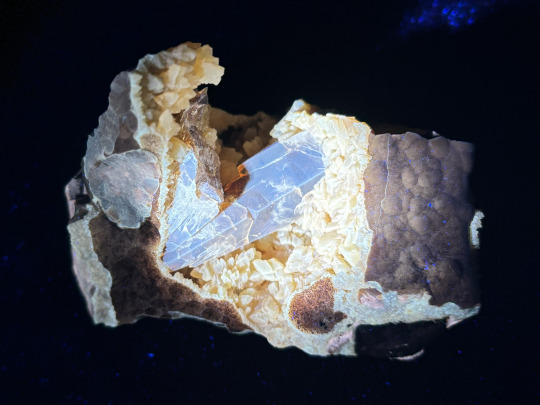
Under a long wave UV light (365nm), the calcite fluoresces yellow, and the barite fluoresces pale blue.
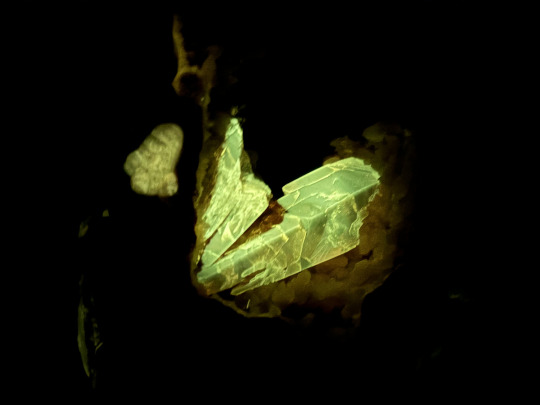
The barite also has very strong yellow-green phosphorescence, meaning it glows in the dark for a while after the UV light is removed!
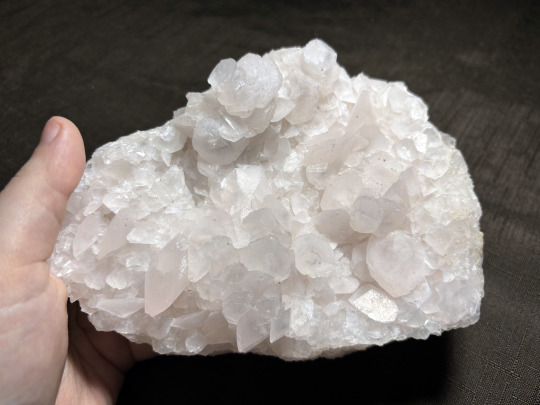
This is mangano calcite, a form of calcite that gets its faint pink color from manganese.

This specimen features lenticular crystals and a cool “pagoda” formation!

And of course, here it is showing off what mangano calcite is most famous for: its gorgeous orange-pink fluorescence.

Here is some classic optical calcite! Although it’s often called "Iceland Spar", this particular specimen is from Mexico.

Optical calcite is known for its birefringence, an optical effect in which it doubles the image behind it! This is because calcite’s crystal structure polarizes the light passing through it, splitting it into horizontal and vertical wavelengths. All calcite technically does this; we can just see it happening in optical calcite because it is very clear and easy to see through.
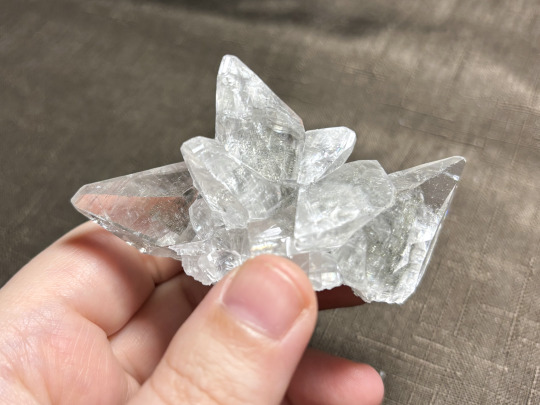
This beautiful, water-clear specimen of dogstooth calcite crystals is from Linwood Mine in Iowa. It features very distinct phantoms!

Phantoms form when a thin layer of some other mineral begins growing on the surface of the crystal. As the calcite continues to grow, that layer becomes trapped inside of the crystal, becoming a faint record of the crystal’s size and shape when it was much younger! Calcite phantoms are especially interesting because their image is distorted by birefringence.
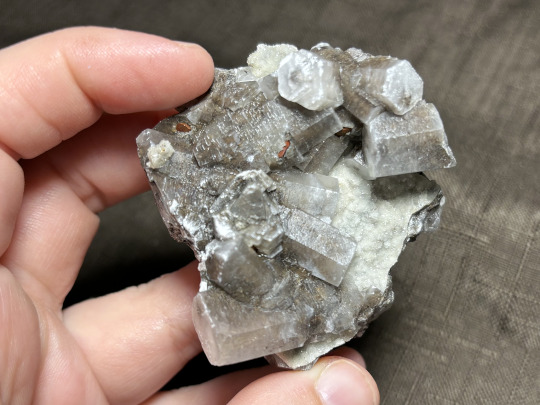
This piece is a columnar calcite from Fujian Provence, China! Note the uncommon column shapes of the crystals.
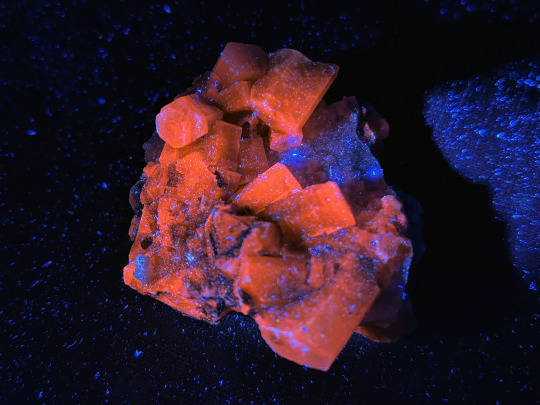
It fluoresces a lovely orange red!

And of course my favorite calcite of all! This specimen is cobaltocalcite from Morocco. While that hot pink color looks totally dyed and fake, it’s actually completely natural! Cobaltocalcite gets its distinctive color from atoms of cobalt in its molecular structure.
There's more calcite in my collection, but these are the best, I think!
334 notes
·
View notes
Text




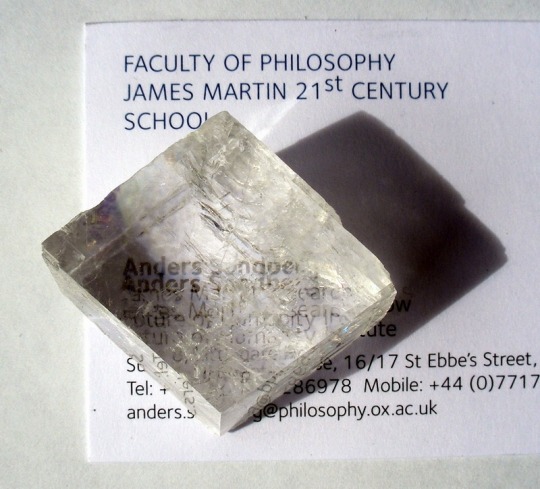
birefringence in calcite
258 notes
·
View notes
Photo

Deep-ultraviolet birefringent hydrogel based on 2D cobalt-doped titanate
A birefringence based light modulator that works in the wavelength region of < 350 nm plays a vital role in DUV beam shaping, high density data storage, semiconductor micro-nano processing and photolithography. Actually, a series of DUV birefringent materials, including single crystals of α-BBO, MgF2, Ca(BO2)2, and α-SnF2, have thus been made and commercially used. However, these birefringent elements have fixed birefringence, limiting their capability of continuous light modulation.
Liquid crystals (LCs) are another kind of birefringent materials, of which birefringence is tunable via the molecular alignment by external electrical or magnetic stimuli. Up to now, the commonly used LCs are mainly based on organic molecules or polymers, which are not stable under DUV light due to photochemical degradation effects. Meanwhile, DUV can also induce free radicals in some organic groups, and initiate their polymerization, which disorders the alignment and the resultant birefringence of LC. Therefore, organic LC cannot modulate DUV light.
In a new paper published in Light Science & Application, three teams of scientists, led by Professor Hui-Ming Cheng and Associate Professor Baofu Ding from Shenzhen Institute of Advanced Technology, CAS, Professor Wei Cai from Xi'an Research Institute of High Technology, Professor Bilu Liu from Tsinghua University, China, cooperatively synthesized two-dimensional (2D) inorganic cobalt-doped titanate (CTO) LC by using a wet chemical method. The 2D LC has large magnetic & optical anisotropy as well as high transmittance of > 70% in the wavelength of 300 ~ 350 nm, which enables the transmitted DUV modulation in a magnetic and portable way (Fig. 1).
Read more.
8 notes
·
View notes
Text
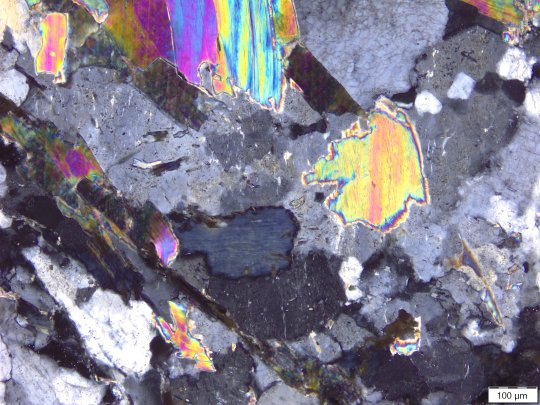

Chlorite can often be found replacing micas. Sometimes I have a hard time noticing it in cross-polar in the first place, given the drastic shift in birefringence colors. Thankfully, plane-polar's got my back.
57 notes
·
View notes
Text

Okay so this Spells list isn't gonna be as extensive as the Winx's list primarily because I have less inspo but here are some
Fun fact, magic affects flying speed! With Stella the fairy of Sun and Moon Light being the fastest flier out of all the girlies in show, but she often doesn't fly that fast in fear of crashing leading to Musa the fairy of Harmonious Sounds to be the fastest in practical application, and Diaspro the fairy of Gemstones being the slowest
🪩 Diaspro Fairy of Gemstones 🪩
💍 Low-level Spells 💍
Gem Creation (🛡️) - The caster can create different types of gems, it's hardness determining how easy or hard it is to make gems
Gem Shot (🛡️⚔️) - The caster creates gems that will speed and attack a target, splintering upon contact
Shield of Gems (🛡️) - A small gem based circular shield
Amber Encasement (🛡️💫) - The caster creates liquid like sap that wraps around a target, hardening and encasing them in amber
↳ Amber Electrification (⚔️) - A high level add on to a low level spell, the caster creates statistic electricity with the amber shocking whatever is trapped inside
Quartz Time Keeper (💫) - Gives caster the ability to keep exact tract of time
Fairy Cross (🛡️💫) - The caster creates staurolite, which can absorb fairy magic particularly well, this makes channeling magic particularly easy. However transferring that magic is impossible without a witch and it will not absorb attack magic, only imbuing magic
💎 Mid-level Spells 💎
Gem Lancer (🛡️) - The caster creates lance like gem that fly at a target, they are much sturdier than gem shot
Agate Bands (🛡️💫) - The castor creates bands that will wrap around and constrict a target
Fool's Deception (🛡️) - The caster uses gem stones to imitate a particular object, will only work if said thing looks like gems in the first place
Phosphorescent Stones (💫🛡️) - The caster creates a gem that can naturally absorb light and later emit the light later
Gem Reflection (🛡️💫) - The caster creates a large gem facet looming shield that reflects attacks
Photonic Bands (🛡️⚔️) - The caster creates a gemstone capable of channeling sun light, and can use it to make colorful beams of light
Birefringence Light Beam (⚔️🛡️) - The caster creates a gem that channels sun light and shoots out two light beams
Tourmaline Magnet (💫🛡️) - The caster creates a tourmaline and can use it to make a weak magnetic pull
👑 High-level Spells 👑
Quartz Shock (⚔️🛡️) - The caster creates quartzes and then compresses it, creating electricity
Coral Grabber (💫🛡️) - The castor creates coral gems in the shape of coral animals that grab targets before hardening
Barrier of Diamond (🛡️) - A extremely powerful barrier that's hard as diamond
Diamond Sword and Shield (🛡️) - Creates a sword and shield out of diamond
Crystalization Barrier (🛡️) - The caster shoots out gemstones that immediately grow and encase the target upon hitting it
Absorption Shield (💫🛡️⚔️) - The caster creates a large jagged shield that is able to absorb certain types of magic thrown at it if it's the correct type of gem
Crystal Oscillator (💫) - The caster creates a quartz that interferes with radio waves
Power of Gems (💫🛡️⚔️) - Creates types of gemstones that are naturally able to absorb power from the nearby environment, much like a Witch's channeling spell. Once the Gemstone absorbs power from the environment it can be used for attacking, defending, and supporting
↳ Absorption Necklace (💫🛡️⚔️) - Essentially the same thing but the caster disguises it as a ordinary necklace
Crystal Cave (🛡️) - The caster creates a huge amount of gemstones, trapping targets inside a enclosure
I wanted to come up with a spell based on the Chinese Writing Stone but I couldn't come up with one. It would act as a messager stone table obviously but I'm unsure of the mechanics ://
Btw look up this stuff, quartz and amber can generate electricity, quartz are used in the construction of radios, it's so cool! Gems can do so much stuff!!!
#winx club#reblog#winx diaspro#winx club diaspro#winx#rus chatters#rus has ideas#winx headcanons#winx club headcanons
15 notes
·
View notes
Note
Can a twilight vampire have the gift of birefringence
Afton has the power to be invisible if nobody's looking, so why not.
21 notes
·
View notes
Text
Another rock post be upon ye!! How about.... OPTICAL CALCITE
Also called Icelandic Spar or even Viking sunstone!

Despite all of the fancy names, optical calcite is essentially just exceptionally clear calcite. However, calcite is so cool and deserves all the love <3
Fun properties, double refraction, and the reason behind the names below the cut!

Calcite is called Icelandic spar, due to the area it was most famously mined. It may be called optical calcite if it is exceptionally clear. Calcite (CaCo3) has several notable qualities! Some that are commonly used for its identification are: 3 on the Mohs hardness scale, twinning, birefringence (if y'all ever want a brain melting post I will totally deep dive into birefringence for y'all, I'll talk about a lot of the basics of it here!), effervescence with hydrochloric acid, and distinct cleavage planes. The cleavage is probably the most well know! Look at those perfect 6-sided polyhedrons below! It has three perfect cleavage planes at 60-120 degree angles.
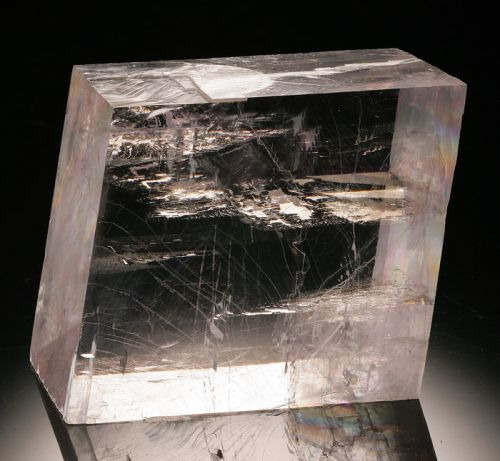
However! What I will be talking about most are the optical properties that give this mineral it's nicknames!
Calcite has a very cool property called double refraction! This is a principle of birefringence (which means that light passing through the crystal refracts at different angles for different polarizations. think polarized lenses in sunglasses that block light moving at a specific angle!). Unpolarized light passes through the calcite and is polarized by the crystal! Splitting it into two rays, one moving in the original direction and one splitting off, causing images to appear doubled!

Since the double-image is caused by the distortion of light as it passes through the crystal, the size of the crystal impacts the spacing of the images (as shown above in the chart and below in an example with three pieces of calcite)

The 'ordinary ray" (original path of light) makes an image that stays in place, but rotating the crystal causes the double of the image (the extraordinary ray) to move. The double image occurs if the direction of the polarization is at an angle to the ordinary ray, rotating the crystal 90 degrees can cause the polarizing direction and the ordinary ray to align, eliminating the double image (shown below).

Interestingly, trilobite eyes are made out of calcite! The many lenses of their eyes are all oriented at the C-axis of the calcite crystal, the only axis that aligns the incoming light and polarized direction, eliminating the double image!
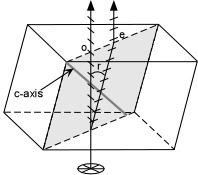
NOW TO THE MOST FUN: WHY IS IT CALLED A VIKING SUNSTONE?
When most people think of a sunstone, they think beautiful feldspars with shimmery orange flecks, or of the man-made, glitter-filled orange stone.
When historians came across discussions of sunstones in Norse texts, they at first thought it was a reference to some mythical stone, or perhaps a real stone tied to mythology in its origin. Then, more texts discussed the use of this "sun stone" in navigation. It wasn't until years later that it was proposed that the sunstone could be calcite, because there was no clear description of how to use a sunstone.
There are two proposed methods for using a sun stone in navigation, the simpler dot method and the more commonly accepted color method (not official names, just the easiest way for me to describe them).
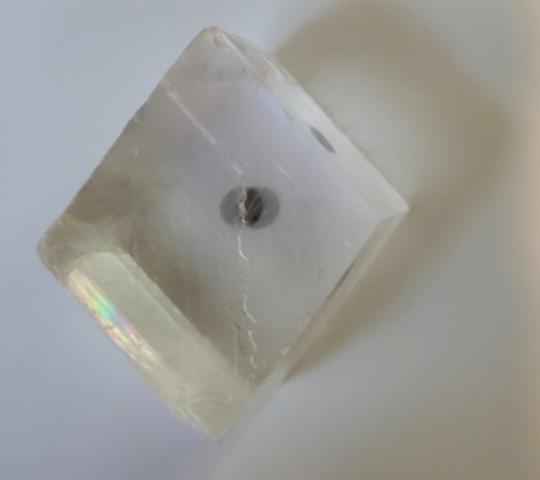
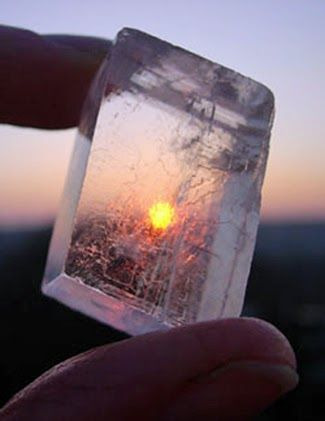
The 'Dot method' involves drawing a mark on one side of the calcite piece. Using the properties we discussed before, and holding the stone at the correct angle, you can calculate the direction of the light source by looking through the stone until the double image of the dot on the opposite side turns into one image. Because rotation affects this process, and because some texts refer to the color yellow, this is the less supported theory.
The 'color method' involves moving the stone until it appears yellow, which is caused by a phenomenon called Haidinger's brush. This makes it so that polarizing minerals may show a yellow pattern when facing away from the sun. This pattern appears more distinct against blue backgrounds (e.g., the sky) and is brightest 90 degrees away from the sun. When tested, it was found that you could calculate the East-West direction within a few degrees by finding the two points where the yellow color was brightest and calculating intersection, even when the sun was behind clouds or set beyond the horizon line.
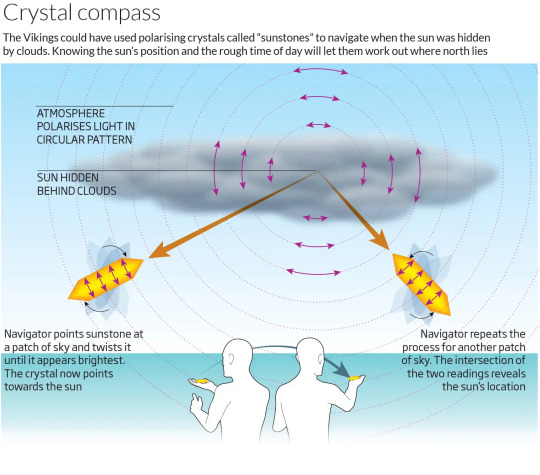
Thanks @earthgeco for requesting more rocks!!! You have activated my trap card. As in. You are now trapped with me as I tell you about rocks. (I have more posts under my rockposting tag as well!)
Image sources: 1, 3, 4, 7, 9, 10
Images from me: 2, 5, 6, 8
#vpoc yells#rockposting#optical calcite#icelandic spar#vpoc has cool rocks#long post#vpoc writes#me writing this: why did my teachers not use these diagrams. why didn't they explain it this way instead. what. huh.
14 notes
·
View notes
Text
Mineral Swag Round 1: You Have to Lick the Rocks
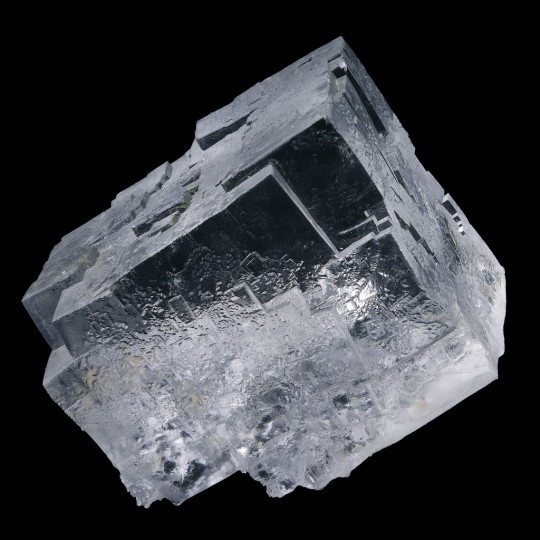

Halite and Calcite. They’re the bane of every Geology 101 student.
Here’s how to tell them apart!
Halite is salt. If you lick it, it’s salty! Halite is the mineral that makes all non-geologists go “Do you really lick rocks?” and you have to be like “Yes, it’s an important identification technique.” Anyway, I have personally licked and chewed several rocks, moving on. Halite has three directions of cleavage at 90 degrees, so halite forms little cubes. The table salt you have? Tiny cubes. It doesn’t have as cool of optical properties as calcite, but it’s the most classic seasoning.
Calcite is a carbonate mineral. It’s made of calcium and carbonate (CaCO3). It fizzes when you put acid on it (sometimes you can get it to fizz with just vinegar!). It has three directions of cleavage that are NOT at 90 degrees to each other. If you have a big enough and clear enough calcite sample, it will also show birefringence - it makes a double of anything you look at through the crystal! (Surprisingly, an optical calcite sample is pretty easy to acquire. They sell them at the Smithsonian Museum of Natural History).
Both of these minerals also come in fun colors and shapes! Halite can of course be pink or red (like Himalayan Salt).

Sometimes it creates salt casts in rock formations. These are basically imprints of halite cubes in sedimentary rocks that tell us that the rocks we're looking at were deposited somewhere with a lot of salt! (Think the Dead Sea or the Great Salt Lake). Halite crystals might end up on the bottom of these bodies of water and get stuck in the substrate. Later, after the substrate has lithified (turned to rock), the halite will dissolve and leave these casts or imprints behind.
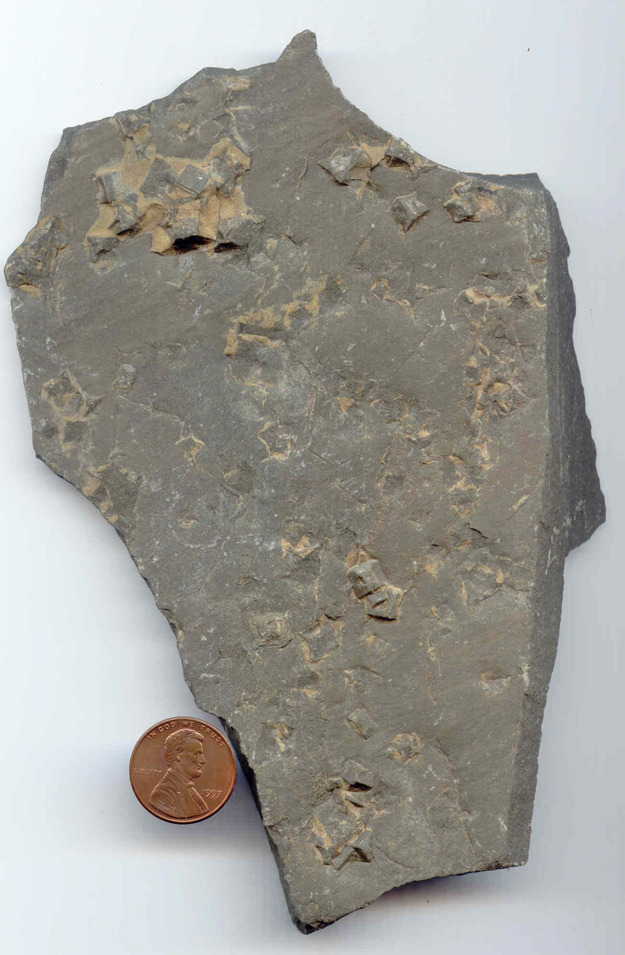
Calcite also comes in different colors like this yellow-orange color, and it can also form scalenohedrons, a fun 12-sided diamond looking shape.

This sample is from a mine in Elmwood, Tennessee, where yellow calcite and purple fluorite are often found together!
51 notes
·
View notes